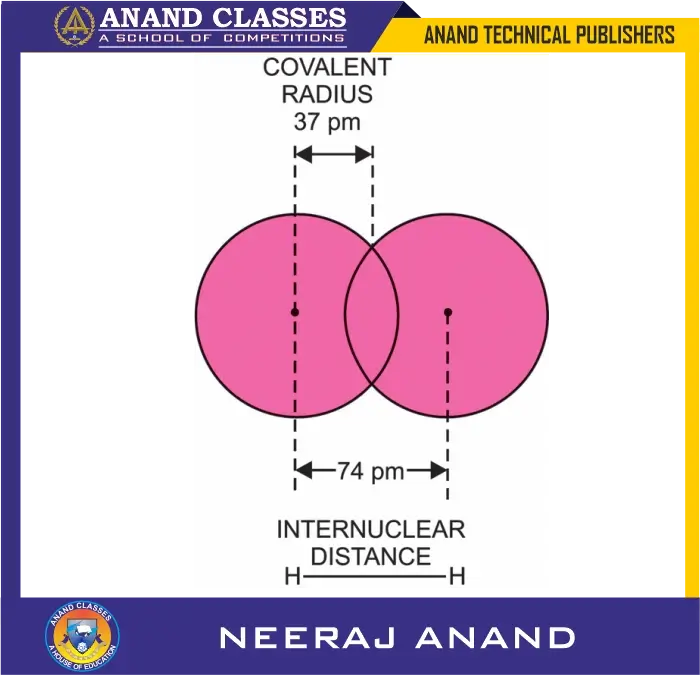Anand Classes Notes explains Atomic radius refers to the distance from an atom’s nucleus to its outermost electron shell, measured in different ways depending on context—covalent radius, metallic radius, or van der Waals radius. Understanding these radius types and their trends is vital for solving Class 11, NEET, and JEE chemistry problems on periodic properties and atomic structure.
Table of Contents
🌟 Atomic Radius
The size of an atom is a very important property because many physical and chemical properties are related to it. If the atom is assumed to be spherical, the atomic size is given by the radius of the sphere and is called the atomic radius.
The radius of an atom is the distance between the centre of its nucleus and electrons in the last orbit.
However, according to quantum mechanics, there is no certainty about the exact position of electrons at any time. Theoretically, an electron, at one time, may be very close to the nucleus while at other time it may be far away from the nucleus. In spite of these limitations we need to have some operational definition of the term atomic radius. There are three operational concepts of atomic radius.
- If the bonding is covalent, the radius is called a covalent radius.
- if the two atoms are not bonded by a chemical bond (as in noble gases) the radius is called van der Waal’s radius.
- If the bonding is ionic, the radius is called ionic radius.
❓ Why Exact Atomic Radius is Difficult to Determine ?
Generally, the term atomic radius means the distance from the centre of the nucleus to the outermost shell of electrons. However, it is difficult to determine the exact radius of the atom because of the following reasons:
- Tiny Size of Atoms :
The size of an atom is approximately 1.2 Å or 1.2 × 10⁻¹⁰ m in radius, which is extremely small. - No Well-Defined Boundary
According to the probability picture of electrons, an atom does not have a well-defined boundary. The probability of finding an electron is never zero—even at large distances from the nucleus. - Atoms Cannot Be Isolated
It is not possible to isolate an atom and measure its radius directly. The atomic radius is also affected by the presence of other atoms in its neighbourhood. Therefore, the size of an atom may change in going from one environment to another. - Changes in Bonded States
The size of an atom also changes from one bonded state to another.
📏 Defining Atomic Radius
Thus, we can only arbitrarily define atomic radius as the effective size, which means:
The distance of closest approach of one atom to another atom in a given bonding situation.
The approximate radii of atoms can be determined by measuring the distance between the centres of two neighbouring atoms (called internuclear distance) in a covalent molecule using:
- X-ray diffraction
- Electron diffraction
- Other spectroscopic techniques
As shown in Figure below, this internuclear distance corresponds to twice the radius of an atom. Therefore, half of this distance gives the atomic radius.
🧪 Types of Atomic Radii
Atomic radii may be assigned different names such as:
- Covalent radius
- Metallic radius
- van der Waals radius
depending upon the type of bonding between the atoms.
🔸 Covalent Radius
It may be defined as:
One half of the distance between the nuclei of two covalently bonded atoms of the same element in a molecule.
For a homonuclear molecule:
$$r_\text{covalent} = \frac{\text{Internuclear distance between two bonded atoms}}{2}$$

🧾 Examples: As shown in Figure above :
- The internuclear distance between two hydrogen atoms in H2 molecule is 74 pm.
- Therefore Atomic radius of hydrogen = 74/2 = 37 pm
- The atomic radii of chlorine and bromine are 99 pm and 114 pm respectively, because the internuclear distances in:
- Cl—Cl = 198 pm
- Br—Br = 228 pm
🔹 Heteronuclear Molecules
In the case of molecules containing different atoms, the covalent radius of an atom may be defined as:
The distance between the centre of the nucleus of the atom and the mean position of the shared pair of electrons between the bonded atoms.
It has been observed that when the covalent radii for different atoms joined by a single covalent bond are added, the resulting value agrees fairly well with the experimentally determined internuclear distance of that molecule.
⚙️ Metallic Radius
In the case of metals, a large number of atoms are closely packed and are held together by strong metallic bonds. This close-packed arrangement of metal atoms is known as the metallic lattice.
📏 Definition of Metallic Radius
Metallic radius is defined as one half of the internuclear distance between two neighbouring atoms in a metallic lattice.
🔍 Example: Copper
For example, the distance between two adjacent copper atoms in metallic copper is 256 pm. Metallic radius of copper=256/2=128 pm.
🧪 Covalent vs Metallic Radius
- The covalent radius gives the size of a non-metallic element when atoms are bonded by a single covalent bond in a covalent molecule.
- The metallic radius gives the size of a metallic element in a metal where atoms are held together by metallic bonds.
🔄 Atomic Radius – A General Term
For simplicity, the term atomic radius may be used for both covalent and metallic radii, depending on whether the element is a non-metal or a metal.
However, it must be noted:
Covalent and metallic radii are always shorter than the atomic radii in uncombined atoms.
This is because:
- A covalent bond is formed by the overlapping of atomic orbitals.
- The overlap region becomes common between the two atoms, reducing the distance between their nuclei.
Frequently Asked Questions (FAQ)
What is the covalent radius?
The covalent radius is half the distance between the nuclei of two identical atoms joined by a single covalent bond. It is used for non-metals that form covalent compounds.
What is the metallic radius?
The metallic radius is half the distance between the nuclei of two adjacent atoms in a metallic lattice. It applies to metals where atoms are packed in a solid metal structure.
What are the different types of atomic radius?
There are three primary types:
Covalent radius: half the distance between the nuclei of two identical atoms joined by a covalent bond.
Metallic radius: half the distance between nuclei in adjacent atoms within a metallic lattice.
van der Waals radius: half the closest distance between non-bonded atoms in neighboring molecules.
How do covalent and metallic radii differ?
Covalent radius is smaller because of strong directional bonding between atoms.
Metallic radius is larger due to non-directional metallic bonding and looser packing of electron clouds.
Which one is larger for the same element – covalent or metallic radius?
For the same element, the metallic radius is generally larger than the covalent radius due to weaker attraction in metallic bonds compared to covalent bonds.
Give an example comparing covalent and metallic radius.
For sodium (Na):
Covalent radius ≈ 154 pm
Metallic radius ≈ 186 pm
This shows that metallic radius > covalent radius.
Why is the metallic radius applicable only to metals?
Because metallic radius is defined based on the structure of metallic solids, where atoms are arranged in a regular pattern and bonded through a sea of delocalized electrons.
In what types of compounds is covalent radius used?
Covalent radius is used in molecules where atoms are held by covalent bonds, such as in H₂, O₂, N₂, Cl₂, CH₄, etc.
Why are there different measurement methods for atomic radius?
Atoms don’t have clear boundaries, so different contexts—such as bonding type or whether atoms are isolated or in solids—require different definitions and measurement techniques.
Why is the Exact Atomic Radius Difficult to Determine?
The exact atomic radius is difficult to determine because:
Atoms do not have sharp boundaries : The electron cloud around the nucleus does not end abruptly; it gradually fades out, making it hard to define where an atom truly “ends”.
Electron cloud is probabilistic : According to quantum mechanics, electrons exist in orbitals with a probability distribution, not fixed orbits. So, the size of an atom is not precise—it depends on where we consider the edge of the cloud to be.
Atomic radius varies with bonding type : The measured radius changes depending on how the atom is bonded (e.g., covalent, metallic, or van der Waals radius), so there’s no single, fixed value for an atom.
Influenced by surrounding atoms: Atomic size can change based on the chemical environment—whether the atom is isolated, bonded, part of a molecule, or in a crystal lattice.
Relies on indirect measurement : Atomic radius is often calculated using inter-nuclear distances between atoms in molecules or solids, not by measuring individual atoms directly.
📌 Conclusion: Due to the diffuse electron cloud, bonding context, and quantum mechanical nature of electrons, the atomic radius is always an approximate or average value, not an exact measurement.
📚 Buy Study Material & Join Our Coaching
For premium study materials specially designed for JEE, NEET, NDA, and CBSE/ICSE Classes, visit our official study material portal:
👉 https://anandclasses.net.in/
To enroll in our offline or online coaching programs, visit our coaching center website:
👉 https://anandclasses.co.in/
📞 Call us directly at: +91-94631-38669
💬 WhatsApp Us Instantly
Need quick assistance or want to inquire about classes and materials?
📲 Click below to chat instantly on WhatsApp:
👉 Chat on WhatsApp
🎥 Watch Video Lectures
Get access to high-quality video lessons, concept explainers, and revision tips by subscribing to our official YouTube channel:
👉 Neeraj Anand Classes – YouTube Channel



